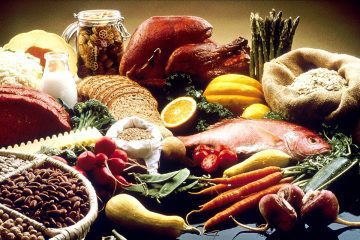Table of Contents
- Mastering the Art of Affordable Meal Planning
- Essential Strategies for Maximizing Every Dollar
- Nutritious Ingredients That Won’t Break the Bank
- Creative Cooking Tips for Tasty, Low-Cost Meals
- Smart Shopping Hacks for Sticking to Your Budget
- Q&A
- Key Takeaways


Mastering the Art of Affordable Meal Planning
When you’re working with a tight food budget of just $20 a week, meal planning becomes not just a skill but an art. The first step is to assess your pantry and fridge. Before hitting the grocery store, take inventory of what you already have. This will help you avoid duplicate purchases and utilize ingredients that might otherwise go to waste. Consider creating a list of staples, such as:
- Rice
- Pasta
- Canned beans
- Frozen vegetables
- Oats
Next, craft a versatile menu plan for the week. Focus on meals that can be easily transformed to keep things exciting. For example, a base of rice can serve as:
- A stir-fry with whatever veggies you have on hand
- A savory rice bowl topped with eggs
- A simple side dish for chili or curry
Utilizing similar ingredients across different meals not only maximizes your resources but also reduces the hassle of cooking. Here’s a sample weekly meal plan that demonstrates how to stretch your $20:
| Day | Meal | Estimated Cost |
|---|---|---|
| Monday | Vegetable Stir-fry | $2.50 |
| Tuesday | Chili with Beans | $3.00 |
| Wednesday | Pasta with Tomato Sauce | $2.00 |
| Thursday | Rice Bowl with Eggs | $2.50 |
| Friday | Oven-Baked Veggies & Quinoa | $3.00 |
| Saturday | Overnight Oats | $1.50 |
| Sunday | Leftover Buffet | $2.50 |
With some creativity and intentional planning, you can easily maintain delicious and satisfying meals within a minimal budget. Don’t forget, batch cooking is your ally. Preparing larger portions allows for leftovers, which not only saves time but also ensures that your meals are ready when you need them. By following these strategies, you can successfully navigate your food journey on just $20 a week without sacrificing flavor or nutrition.


Essential Strategies for Maximizing Every Dollar
Effectively managing your food budget of $20 a week requires strategic planning and a bit of creativity. Start by creating a weekly meal plan that stretches your dollar while ensuring nutritious choices. Utilize inexpensive staples that can form the backbone of numerous meals. Think rice, beans, lentils, and seasonal vegetables, which can all be purchased in bulk for significant savings. This approach not only minimizes food waste but also encourages variety throughout the week.
Next, leverage local sales and grocery discounts to maximize your purchasing power. Prepare a shopping list that aligns with your meal plan, but also home in on seasonal sales that grocery stores frequently offer. Using coupons and apps can further complement your savings. Additionally, consider visiting local farmers’ markets or discount grocery stores, which can often provide fresh produce at lower prices compared to traditional retailers.
don’t overlook the potential of batch cooking and meal prepping. By dedicating a portion of your weekend to cooking larger quantities of meals, you not only secure savings but also simplify your week ahead. Store prepared portions in containers for quick access, making it less likely you’ll reach for expensive takeout when time is tight. This practice can effectively reduce your food costs while ensuring you stay within your budget.


Nutritious Ingredients That Won’t Break the Bank
Eating healthy on a tight budget is entirely possible with a little creativity and smart shopping. Beans are an excellent staple that packs a nutritional punch. They are rich in protein, fiber, and essential vitamins, making them a versatile ingredient for salads, soups, and stews. A bag of dried beans costs significantly less than canned options, stretching your food dollars further. Pair them with rice for a complete meal that’s both filling and affordable. This dynamic duo creates a hearty base for dishes that can be seasoned in countless ways.
Don’t underestimate the power of frozen vegetables. Often just as nutritious as fresh produce, frozen veggies are a budget-friendly way to boost the nutritional value of any meal. They have a longer shelf life, allowing for flexibility in meal planning without worrying about spoilage. Broccoli, spinach, and carrots are among the top choices for quick stir-fries or side dishes. Opting for seasonal fruits can also enhance your budget-friendly diet. Fruits like bananas, apples, and oranges provide essential vitamins and can often be found at lower prices, especially in bulk.
| Ingredient | Approximate Cost | Nutritional Benefits |
|---|---|---|
| Beans | $1.50 per lb | Protein, Fiber, Iron |
| Rice | $0.80 per lb | Carbohydrates, B Vitamins |
| Frozen Vegetables | $2.00 per bag | Vitamins, Minerals, Antioxidants |
| Seasonal Fruits | $2.00 per lb | Vitamins, Fiber |
consider incorporating oats into your meals. Oats are a low-cost, nutrient-dense grain that serves as a great breakfast option or can be used in baking. They are high in soluble fiber, which promotes heart health and aids digestion. Cooking them in larger batches can provide a quick, healthy breakfast for several days. Additionally, the versatility of oats allows for various toppings, from fruit to nuts, ensuring you never grow tired of this wallet-friendly staple.


Creative Cooking Tips for Tasty, Low-Cost Meals
Cooking delicious meals on a tight budget requires a sprinkle of creativity and resourcefulness. Start by exploring your local markets for seasonal produce. These items are often fresher and cheaper, making them perfect for hearty meals. When planning your dishes, prioritize versatile ingredients that can be used in various recipes, such as:
- Rice: A filling base for stir-fries or casseroles.
- Lentils: Packed with protein and ideal for soups and salads.
- Eggs: Great for breakfast, lunch, or dinner, offering endless cooking possibilities.
Batch cooking is another fantastic strategy to stretch your food budget. Prepare large portions of meals that freeze well, such as chili, stews, or pasta bakes. Not only does this save you time during the week, but it also minimizes food waste. Organize your meals in labeled containers, making it easy to grab and go. Here’s a simple table that outlines some budget-friendly dishes along with their key ingredients:
| Dishes | Key Ingredients |
|---|---|
| Vegetable Stir-Fry | Seasonal veggies, soy sauce, rice |
| Lentil Soup | Lentils, carrots, celery, broth |
| Egg Fried Rice | Leftover rice, eggs, peas, soy sauce |
Lastly, don’t overlook the power of spices and herbs in transforming simple ingredients into flavorful dishes. A well-stocked spice rack can elevate your meals without significantly impacting your budget. Experimenting with various herbs can alter the taste dramatically, so consider adding items like:
- Garlic: Enhances almost any dish.
- Oregano: Complements Italian and Mediterranean fare.
- Cumin: Adds depth to soups and stews.


Smart Shopping Hacks for Sticking to Your Budget
When managing a tight food budget of just $20 a week, smart shopping strategies become essential. Start by planning your meals around sales and seasonal produce. Check your local grocery store’s weekly flyer to pinpoint discounts on fruits, vegetables, and staple items. Creating a meal plan tailored to these savings allows you to maximize freshness while minimizing costs. Additionally, consider using what you already have at home to avoid unnecessary purchases. A quick inventory of your pantry can help you incorporate ingredients you might otherwise overlook.
Taking advantage of bulk purchasing can dramatically stretch your dollars. Look for items like rice, pasta, beans, and oatmeal that often come at a lower unit price when bought in larger quantities. While it may seem counterintuitive with a strict budget, buying in bulk can significantly reduce the cost per serving. Just ensure you have the storage space to keep these items fresh. Combine this with strategies such as shopping at warehouse stores or local farmers’ markets, which often provide quality goods at competitive prices.
Lastly, embrace creativity in your cooking. Experimenting with cost-effective recipes can not only keep your meals interesting but also ensure you’re utilizing your ingredients efficiently. Search for dishes that require minimal ingredients or utilize leftovers creatively. For example, transforming yesterday’s roasted vegetables into a hearty soup can be both economical and delicious. Below is a simple table summarizing a few meal ideas that align with your budget:
| Meal | Ingredients | Estimated Cost |
|---|---|---|
| Vegetable Stir-Fry | Frozen veggies, soy sauce, rice | $4 |
| Chickpea Salad | Canned chickpeas, cucumber, dressing | $3 |
| Pasta Primavera | Pasta, seasonal vegetables, olive oil | $5 |
| Oatmeal with Fruit | Oats, banana, honey | $2 |
| Vegetable Soup | Broth, mixed vegetables, herbs | $4 |
Q&A
Q&A: How to Budget for Food on $20 a Week
Q1: Is it really possible to eat healthy on a $20 food budget each week?
A1: Yes, it is definitely possible! Eating healthy on a $20 budget requires careful planning and creativity. Focus on purchasing staple foods such as grains, legumes, seasonal vegetables, and fruits. When you prioritize whole foods and plan your meals around what’s on sale, you’ll find you can maintain a nutritious diet without breaking the bank.Q2: What are some tips for meal planning on a tight budget?
A2: Meal planning is key to maximizing your $20 budget. Start by making a list of affordable ingredients and then plan your meals around those items. Batch cooking can also help — prepare larger portions to last multiple meals. Incorporate versatile ingredients that can be used in various dishes, like rice, beans, and frozen vegetables, to stretch your budget further.Q3: How can I make a grocery list that fits within the $20 limit?
A3: To create a budget-friendly grocery list, follow these steps:- Inventory Check: Look at what you already have at home to avoid duplicates.
- Seasonal and Local: Shop for seasonal produce and local items, which are often cheaper and fresher.
- Basic Staples: Include affordable staples like rice, pasta, canned tomatoes, and beans.
- Protein Sources: Look for cost-effective protein sources, such as eggs or lentils.
- Use Flyers: Check local grocery store flyers for deals and discounts before finalizing your list.
Q4: What types of meals can I prepare on a $20 budget?
A4: With careful planning, you can prepare a variety of meals! For example:- Breakfast: Oatmeal topped with seasonal fruit or scrambled eggs with toast.
- Lunch: Lentil soup with bread or a vegetable stir-fry over rice.
- Dinner: Pasta with marinara sauce and a side of sautéed greens or beans with rice paired with mixed vegetables.
Q5: What are some common mistakes to avoid when budgeting for food?
A5: Some common pitfalls include:- Not Planning Ahead: Failing to plan meals can lead to impulse buys and wasted food.
- Overpriced Items: Avoid gourmet products or pre-packaged meals, which can quickly guzzle your budget.
- Ignoring Leftovers: Don’t let leftovers go to waste! Repurpose them into new meals for added savings.




0 Comments